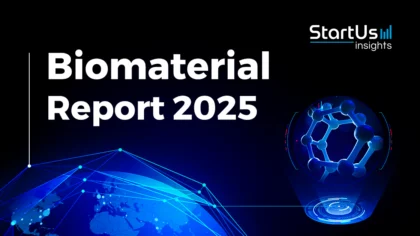Our Innovation Analysts recently looked into emerging technologies and up-and-coming startups working on solutions for the materials sector. As there is a large number of startups working on a wide variety of solutions, we decided to share our insights with you. This time, we are taking a look at 5 promising 2D material solutions.
Heat Map: 5 Top 2D Material Solutions
Using our StartUs Insights Platform, covering 1.116.000+ startups & emerging companies, we looked at innovation in the field of materials. For this research, we identified 279 relevant solutions and picked 5 to showcase below. These companies were chosen based on a data-driven startup scouting approach, taking into account factors such as location, founding year, and technology among others. Depending on your specific criteria, the top picks might look entirely different.
The Global Startup Heat Map below highlights 5 startups & emerging companies developing 2D material solutions. Moreover, the Heat Map reveals regions that observe a high startup activity and illustrates the geographic distribution of all 279 companies we analyzed for this specific topic.
Advanced Material Development – 2D Material Dispersion
Mixing 2D materials, like graphene and hexagonal boron nitride that have only one layer of atoms, with other materials result in new wonder materials. The combination alters the resultant materials’ properties and becomes stronger, more conductive, and flexible. 2D materials also have a wide range of applications in industries such as automotive, electronics, nanoengineering, and materials. This drives startups and emerging companies to work on innovative 2D materials dispersion solutions.
British startup Advanced Material Development builds a scalable, patented platform technology for 2D materials dispersions. The startup uses graphite nanoplatelets, Hexa-boron nitride, and transition metal dichalcogenides for onward formulations, as well as for commercial application development. These formulations also aid in producing highly conductive inks and coatings.
Applied Nanolayers – Chemical Vapor Deposition (CVD)
The semiconductor industry usually applies processes like CVD to manufacture thin sheets of materials. CVD augments substrate more efficiently when compared to traditional surface modification techniques. Such thin films and monolayered materials exhibit optimal lubricity and hydrophobicity. As a result, 2D materials find use cases in integrated circuits, photovoltaic devices, desalination, and wastewater treatment.
Dutch startup Applied Nanolayers produces monolayered graphene and 2D material sheets with low defect density. Advanced CVD systems enable the wafer-scale cold film to integrate better with silicon, carbon, gallium arsenide, and indium phosphide. Moreover, these wafer scales help coat semiconductors, membranes, sensors, photonics, and spintronics.
Evercloak – 2D Material Coating For Large Surfaces
Due to the weak nature of van der Waals force present between graphene layers, it is very easy to splice a single layer of graphene from bulk graphite. Modern advancements in materials science help to merge graphene with many substances and form coatings that improve the conductivity of resultant materials. As a result, emerging companies are developing various material combinations for coating large area monomolecular layers.
Canadian startup Evercloak offers a manufacturing platform for continuous large-area exfoliation of 2D materials. With the help of an energy-efficient proprietary manufacturing process, the startup exfoliates large areas with 2D materials like graphene, graphene oxide, and molybdenum disulfide. Further, this CVD process allows manufacturing companies to be more cost-efficient.
FlexeGRAPH – Nanofluids
Ideal coolants usually possess high thermal capacity, low viscosity, and are chemically inert. Traditionally, deionized water is used as a coolant due to its low electrical conductivity. With the advancement in 2D materials, fluids like water mixed with nanoparticles such as, for example, silica, alumina, and titanium dioxide, are suitable options for coolants. Startups are developing nanofluids for efficient thermal loads.
Australian startup FlexeGRAPH produces nanofluids for industrial purposes. With the help of patented graphene-based technology, the startup’s customized nanofluids handle varying thermal loads and reactions to different industrial processes. This enables the startup to provide much better heat exchange when compared to existing solutions.
DENSsolutions – 2D Materials For Thermal Studies
Materials innovation requires intensive studies that involve observing various reactions to different parameters like thermal loads and conductivity. In particular, Transmission Electron Microscopy (TEM) represents a process where a beam of electrons passes through a given sample to form images. This opens up opportunities for material science startups to build innovative nano-chips and sample holders that are fully capable of handling intense thermal loads.
Dutch company DENSsolutions provides 2D in-situ heating solutions for TEM. The Wildfire Nano-Chips used for thermal TEM is configured with amorphous silicon nitride and is capable of withstanding extremely high temperatures. Consequently, the nano-chip ensures temperature homogeneity and has a life of more than 90 hours at elevated temperatures.
What About The Other 274 Solutions?
While we believe data is key to creating insights it can be easy to be overwhelmed by it. Our ambition is to create a comprehensive overview and provide actionable innovation intelligence so you can achieve your goals faster. The 5 2D material solutions showcased above are promising examples out of 279 we analyzed for this article. To identify the most relevant solutions based on your specific criteria, get in touch.









